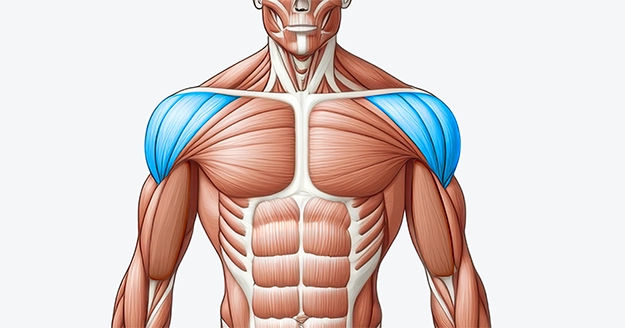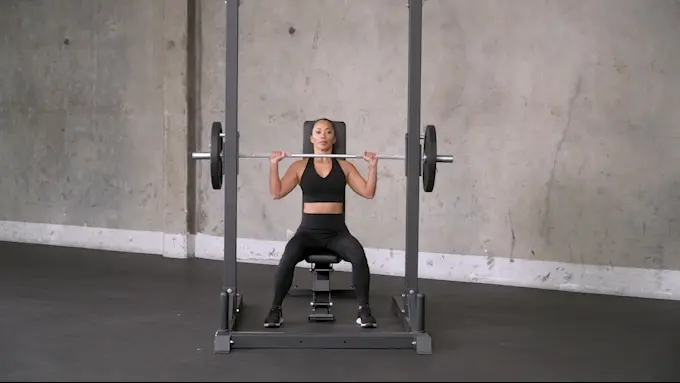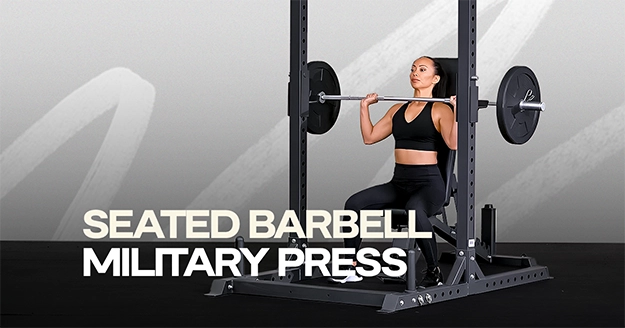Exercise Profile
Seated Barbell Military Press Overview
The seated military barbell press, also known as the seated shoulder press or sitting shoulder press, is a foundational upper-body exercise that strengthens the shoulder muscles and improves overhead pressing strength. Unlike the standing version, the seated press minimizes the use of leg drive, allowing you to focus almost entirely on the upper body to lift the barbell.
Functional fitness practitioners and everyday lifters can also benefit from the seated shoulder press as it mimics the mechanics needed in many daily tasks that require pushing or lifting objects overhead.
Overall, the seated military press is valued for building significant upper body strength and muscle while promoting better posture, functional core stability, and shoulder health. It is a staple in a comprehensive strength-training program because of its adaptability and efficiency in building the upper-body muscles.

Seated Barbell Military Press Instructions
Step 1: Set the incline bench to a 90-degree angle. Rack a barbell, then sit on the bench with your lower back and shoulders against the pad. Grip the barbell slightly outside of shoulder-width, palms facing forward.
Step 2: Put some tension in your core and unrack the bar, holding it above your head.
Step 3: With control, slowly lower the barbell toward your upper chest. Make sure your wrists and elbows line up.
Step 4: When the bar comes into contact with your chest, push your feet on the floor and press your arms up under control.

Seated Barbell Military Press Tips
- Keep your shoulders back and your chest up throughout.
- At the top of the movement, let the elbows spin and point outward; at the bottom, tuck them tightly to the rib cage.
- Rest the bar on the base of your palms for better control and positioning. This also helps extend your wrists, with knuckles pointed toward the ceiling.
- Brace your abs as you press. You shouldn’t be arching your lower back excessively.
Seated Barbell Military Press Common Mistakes
- Failing to Control the Descent: Dropping the bar quickly or without control on the way down reduces muscle activation and increases the risk of injury.
- Inconsistent Elbow Positioning: Letting the elbows flare out too much at the bottom of the movement can strain the shoulder joints, while tucking them too close can reduce leverage.
- Neglecting Shoulder Mobility Warm-Up: Injury might result from jumping right into heavy pushes without first warming up the shoulder joints and muscles.
- Not Engaging the Core: Neglecting core engagement can make it harder to maintain stability and increase the risk of back strain.
- Improper Grip Width: A too wide or narrow grip can reduce effectiveness and increase strain on the shoulders and wrists.
Frequently Asked Questions
What’s the ideal grip width for the seated barbell military press?
A shoulder-width or slightly wider grip is generally ideal, as it aligns the forearms vertically under the bar for efficient pressing and minimizes wrist and shoulder strain.
Should I use a backrest for the seated barbell military press?
Yes, using a bench with a backrest helps support the torso, reduces strain on the lower back, and promotes better form, allowing you to press with more stability and control.
How can I increase my strength in the seated barbell military press?
Add progressive overload by progressively adding weight and supplement your training with shoulder, tricep, and core exercises like lateral raises, pushdowns, and planks to build supporting muscle strength.
Post your post-workout selfies in IG and tag @trainestapp, #trainest, or DM them to us to get a shoutout on Trainest Stories!



